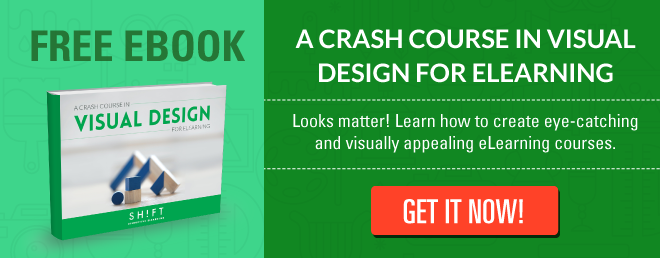It's so easy to assume the content is all that matters in an eLearning course. But, how information is presented affects its effectiveness. The design, for instance, influences how students interact with information.
Think about one of your existing eLearning course designs: Is it too cluttered? Or is it designed to properly guide learners toward clear goals?
It goes without saying that for any learning environment to be effective, you have to think of the holistic learner experience.
Here are four crucial factors that should consider:
- Graphic Clarity
- Readability
- Usability
- Learnability
1. Graphic Clarity
This principle of good design goes beyond how the screen looks. It is rather focused on how the screen conveys information—the form.
Remember, the goal is always to communicate information in the clearest and most accurate way possible. Design should be consistent and aesthetically pleasing to guide the learner every step of the way. Your use of graphics shouldn't be for mere decoration or for filling an empty space. Every graphic element should contribute to the educational purpose of your material and help students achieve their learning goals.
Take a look at any screen right now. Does it actually "inform" or promote better communication? If it easily distracts, then you're nowhere near achieving graphic clarity. Be mindful of the learner's cognitive load.
Some helpful tips: Take away the clutter by getting rid of those elements that obscure your message. A cluttered screen makes it harder for the eyes to read. But a simple, clear design—one that guides the eyes smoothly along with the screen—definitely makes learning much more effective. You can use or combine different elements from lines, color, or whitespace to create a visual flow and guide learners to their ultimate goal.
Recommended read: How To Avoid Designing Cluttered eLearning Screens
2. Readability
Readability on screen is quite different from readability on traditional mediums like paper. This is mainly because the information is presented differently online.
Remember, students don't only read chunks of paragraphs online. They also interact with information in a lot of ways. They click on a link and hover their mouse on a particular image or location. These links and annotations allow them more access to information.
Good readability, then, is about helping your students understand the content. If the text can't be read easily, for instance, then your material simply fails to deliver. Since readability is an essential aspect of comprehension, it's necessary to consider the ease with which students can read the text. Can they scan it quickly? Even on different browsers and devices? What about the hover text? Can they recognize links?
3. Usability
You probably have heard a lot about usability these days. But what is it really?
Jakob Nielsen of the Nielsen Norman Group defines usability as “a quality attribute that assesses how easy user interfaces are to use.”
In the eLearning field, usability considers how user interfaces easily allow students to perform typical learning-related tasks. When a student views a screen, the primary question is whether that screen is usable for their purpose as a student?
Let's take an eLearning course you've created. Can students easily navigate their way from screen to screen? Can they effortlessly move back and forward or wherever they need to get to? And once they get to their intended screen, can they intuitively do what they're supposed to do? If the answer is yes, then there's no doubt that your material scores high in terms of usability.
To check for usability, watch out for broken navigation links, cluttered navigation systems, vague menu options and labels, non-descriptive titles or pages, and missing images or graphics.
Also read:
How Usable is Your eLearning Course? Follow the 5 E’s For Best Results
Don't Frustrate Your Learners! 7 Rules for Creating User-Friendly eLearning4. Learnability
People often confuse learnability with usability. While these two are similar concepts, they are a bit different.
Based on several works by authors such as McLuhan, Arnheim, and Elkins, learnability considers how well a page or screen promotes learning and thinking. To test for the "learnability" of an eLearning course, professionals would have to ask “How learnable is the course?” or “Does this screen help people learn?”
These questions focus on learning-centered usability. The page or screen may be usable. It may enable students to complete tasks. But does it actually help them learn? Obviously, usability and learnability are inextricably linked. One cannot exist without the other.
To check whether an interface is "learnable," it has to present material in such a way that it encourages students to learn. Instead of just relying on dry and informational-thin PowerPoint slides or simply moving traditional format to the web, for instance, the screen has to fully take advantage of effective design and instructional design principles that best adapt to online screens.
Recommended reads:
Understand These 10 Principles of Good Design Before You Start Your Next eLearning Project
Use These 5 Instructional Design Strategies to Create an Effective eLearning Course


